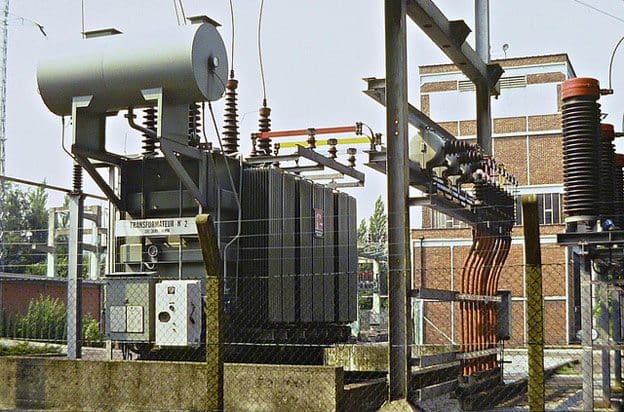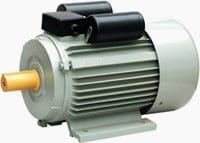
An interconnected power system is a complex enterprise that may be subdivided into the following major subsystems:
• Generation Subsystem
• Transmission and Subtransmission Subsystem
• Distribution Subsystem
• Utilization Subsystem
• Transmission and Subtransmission Subsystem
• Distribution Subsystem
• Utilization Subsystem
Generation Subsystem
Generation subsystem includes generators and transformers.
Generators

Three-phase ac generator from around 1895
An essential component of power systems is the three-phase ac generator known as synchronous generator or alternator. Synchronous generators have two synchronously rotating fields: One field is produced by the rotor driven at synchronous speed and excited by dc current. The other field is produced in the stator windings by the three-phase armature currents.
The dc current for the rotor windings is provided by excitation systems. In the older units, the exciters are dc generators mounted on the same shaft, providing excitation through slip rings. Current systems use ac generators with rotating rectifiers, known as brushless excitation systems. The excitation system maintains generator voltage and controls the reactive power flow. Because they lack the commutator, ac generators can generate high power at high voltage, typically 30 kV.
The source of the mechanical power, commonly known as the prime mover, may be hydraulic turbines, steam turbines whose energy comes from the burning of coal, gas and nuclear fuel, gas turbines, or occasionally internal combustion engines burning oil.

A steam turbine used to provide electric power
Steam turbines operate at relatively high speeds of3600 or 1800 rpm. The generators to which they are coupled are cylindrical rotor, two-pole for 3600 rpm, or four-pole for 1800 rpm operation. Hydraulic turbines, particularly those operating with a low pressure, operate at low speed. Their generators are usually a salient type rotor with many poles. In a power station, several generators are operated in parallel in the power grid to provide the total power needed. They are connected at a common point called a bus.
With concerns for the environment and conservation of fossil fuels, many alternate sources are considered for employing the untapped energy sources of the sun and the earth for generation of power. Some alternate sources used are solar power, geothermal power, wind power, tidal power, and biomass.
The motivation for bulk generation of power in the future is the nuclear fusion. If nuclear fusion is harnessed economically, it would provide clean energy from an abundant source of fuel, namely water.
Transformers

High voltage transformer 40MVA
The transformer transfers power with very high efficiency from one level of voltage to another level. The power transferred to the secondary is almost the same as the primary, except for losses in the transformer.
Using a step-up transformer will reduce losses in the line, which makes the transmission of power over long distances possible.
Insulation requirements and other practical design problems limit the generated voltage to low values, usually 30 kV. Thus, step-up transformers are used for transmission of power. At the receiving end of the transmission lines step-down transformers are used to reduce the voltage to suitable values for distribution or utilization.
The electricity in an electric power system may undergo four or five transformations between generator and consumers.
Transmission and Subtransmission Subsystem
An overhead transmission network transfers electric power from generating units to the distribution system which ultimately supplies the load.
Transmission lines also interconnect neighboring utilities which allow the economic dispatch of power within regions during normal conditions, and the transfer of power between regions during emergencies.
Standard transmission voltages are established in the United States by theAmerican National Standards Institute (ANSI). Transmission voltage lines operating at more than 60 kV are standardized at 69 kV, 115 kV, 138 kV, 161 kV, 230 kV, 345 kV, 500 kV, and 765 kV line-to-line.
Transmission voltages above 230 kV are usually referred to as extra-high voltage (EHV).
High voltage transmission lines are terminated in substations, which are called high-voltage substations, receiving substations, or primary substations.
The function of some substations is switching circuits in and out of service; they are referred to as switching stations. At the primary substations, the voltage is stepped down to a value more suitable for the next part of the trip toward the load. Very large industrial customers may be served from the transmission system.
The portion of the transmission system that connects the high-voltage substations through step-down transformers to the distribution substations is called the subtransmission network. There is no clear distinction between transmission and subtransmission voltage levels.
Typically, the subtransmission voltage level ranges from 69 to 138 kV. Some large industrial customers may be served from the subtransmission system. Capacitor banks and reactor banks are usually installed in the substations for maintaining the transmission line voltage.
Distribution Subsystem
The distribution system connects the distribution substations to the consumers’ service-entrance equipment. The primary distribution lines from 4 to 34.5 kV and supply the load in a well-defined geographical area.
Some small industrial customers are served directly by the primary feeders. The secondary distribution network reduces the voltage for utilization by commercial and residential consumers. Lines and cables not exceeding a few hundred feet in length then deliver power to the individual consumers.
The secondary distribution serves most of the customers at levels of 240/120 V, single-phase, three-wire; 208Y/120 V, three-phase, four-wire; or 480Y/277 V, three-phase, four-wire. The power for a typical home is derived from a transformer that reduces the primary feeder voltage to 240/120 V using a three-wire line.
Distribution systems are both overhead and underground. The growth of underground distribution has been extremely rapid and as much as 70 percent of new residential construction is via underground systems.
Load Subsystems
Power systems loads are divided into industrial, commercial, and residential.

Heavy-Duty Single-Phase Capacitor Start And Run Induction Motor
Industrial loads are composite loads, and induction motorsform a high proportion of these loads. These composite loads are functions of voltage and frequency and form a major part of the system load.
Commercial and residential loads consist largely of lighting,heating, and cooking. These loads are independent of frequency and consume negligibly small reactive power. The load varies throughout the day, and power must be available to consumers on demand.
The daily-load curve of a utility is a composite of demands made by various classes of users.
The greatest value of load during a 24-hr period is called the peak or maximum demand. To assess the usefulness of the generating plant the load factoris defined. The load factor is the ratio of average load over a designated period of time to the peak load occurring in that period. Load factors may be given for a day, a month, or a year.
The yearly, or annual load factor is the most useful since a year represents a full cycle of time.
The daily load factor is:
Daily L.F. = average load / peak load (1.1)
Multiplying the numerator and denominator of (1.1) by a time period of 24 hr, we obtain:
Daily L.F. = average load x 24 hr / peak load
Daily L.F. = energy consumed during 24 hr / peak load x 24 hr (1.2)
The annual load factor is:
Annual L. F. = total annual energy / peak load x 8760 hr (1.3)
Generally there is diversity in the peak load between different classes of loads, which improves the overall system load factor.
In order for a power plant to operate economically, it must have a high system load factor. Today’s typical system load factors are in the range of 55 to 70 percent. Load-forecasting at all levels is an important function in the operation, operational planning, and planning of an electric power system. Other devices and systems are required for the satisfactory operation and protection of a power system.
Some of the protective devices directly connected to the circuits are called switchgear. They include instrument transformers, circuit breakers, disconnect switches, fuses and lightning arresters. These devices are necessary to deenergize either for normal operation or on the occurrence of faults.
The associated control equipment and protective relays are placed on switchboards in control houses.
Reference: Electrical Energy Systems by Mohamed E. El-Hawary (Dalhousie University)
No comments:
Post a Comment